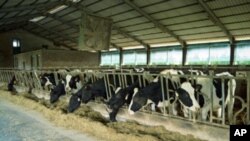U.S. regulators are taking steps to check the spread of antibiotic-resistant infections from animals to humans. The Food and Drug Administration, or FDA, is giving farmers three years to end their practice of using antibiotics solely to help animals grow. The European Union already has banned this use of antibiotics, but it is common in the developing world.
The Food and Drug Administration has issued guidelines for phasing out the use of antibiotics for purposes other than treating, controlling or preventing disease.
Today, the use of small doses of antibiotics to promote animal growth is a common practice in large-scale livestock operations around the world. But new strains of infectious bacteria resistant to these drugs are on the rise.
Antibiotic misuse in people is one factor, says FDA Deputy Commissioner Michael Taylor.
“But we know the use of medically important drugs for production purposes in food producing animals is a contributing factor," said Taylor.
The new guidelines put these drugs under the supervision of veterinarians.
The animal drug industry says livestock use is a minor factor in antibiotic resistance.
But Ron Phillips with the industry trade association, the Animal Health Institute, says his group worked with FDA on the new guidelines.
"This puts us on a path toward where all antibiotic use in animal medicine is going to be used for the therapeutic purposes of treating, controlling and preventing disease, which is important not only to animal health, but to human health," said Phillips.
University of Minnesota infectious disease expert James Johnson says the FDA’s decision is good news that has been a long time coming.
“This is encouraging," said Johnson. "It’s nice to see FDA being proactive. Well, frankly, it’s a little hard to give them credit with being proactive because it’s been so many decades. But they’re finally moving. Okay, good.”
The FDA first proposed banning non-therapeutic use of some antibiotics in 1977.
The guidelines are voluntary, which some critics say might not be enough to motivate farmers to comply. The FDA says it will review progress toward compliance in three years.
Laura Rogers with the non-profit Pew Campaign on Human Health and Industrial Farming says the FDA’s action is a positive step. But she says she is concerned that antibiotic use will not change much.
“If you were to ask me what’s the biggest gap, it’s that they’ve left way too much wiggle room [leeway] when it comes to preventative uses," said Rogers. "That’s going to have to be shored up [i.e., made more specific] in order for this action to be meaningful.”
Rogers says that preventing livestock disease that might result from overcrowding or unsanitary conditions is a common use for antibiotics in animals.
In developing countries, antibiotic use is believed to be widespread on large-scale farms. But data is scarce, says Danilo Lo Fo Wong, an antibiotic resistance expert with the World Health Organization.
“They’re making the same mistakes that developed countries have gone through, which, in my view, is, of course, unnecessary," said Lo Fo Wong. "They could go straight to the better solutions rather than go through the same evolution that developed countries have gone through.”
Lo Fo Wong says the U.S. experience is instructive. And for countries trading with the United States, limiting antibiotic use might become a requirement as import rules tighten.
News
US Regulators Call for Limits on Antibiotic Use in Livestock





